Welcome to “Hawaiian Culture” Part 2 of our blog series, “HĀ: Breath of Life”, an in-depth look into the cultures of Polynesia, as presented in the Polynesian Cultural Center’s spectacular evening show.
“The first three letters of the Hawaiian word “Aloha” form the word “Alo,” which translates to “presence.” Therefore “Aloha” literally means “in the presence of HĀ.” In the Polynesian belief, it is HĀ: Breath of Life, that creates a living being.”
-Excerpt from HĀ: Breath of Life Playbill
Happy Birthday Dear Mana!
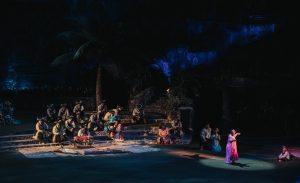
In Hawaiian Culture birthdays are often celebrated with lūʻaus
Lūʻaus are a traditional form of ‘aha‘aina meaning “gathering meal” which are often used to celebrate significant events. In early Hawaiian history, infant mortality rates were very high. For this reason, when children lived to their 1st birthday it was a momentous occasion, often celebrated with a lūʻau. This tradition is still popular today. A birthday lūʻau, for the main character Mana, sets the scene for Act Two of “HĀ: Breath of Life”.
The word lūʻau comes from a popular dish of chicken and taro plant (lūʻau) leaves baked in coconut milk. Though food is obviously a significant part of a lūʻau, (read more about delicious lūʻau dishes), the Hawaiʻi section of HĀ focuses on the other side of lūʻau tradition: the show.
Hula in Hawaiian Culture
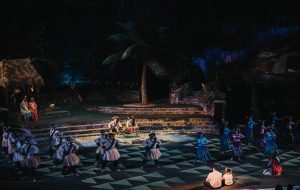
Men and women performing hula kahiko (traditional style)
Hula plays a significant role in Hawaiian culture. Today there are two primary forms of hula. First is Hula ’auana, which combines the traditional form of the dance with western influences such as ukuleles and steel guitars. The second form is Hula kahiko, which is hula in it’s purest form. It is performed in a traditional style without modern instruments, instead using instruments such as bamboo sticks cut so they slap together or drums and rattles carved from gourds. You can see some of these instruments in use during HĀ.
The hula featured at the beginning of the Hawaiian section, performed to a chant by men and women, is an example of the kahiko (traditional) style. The other hula performances are examples of ’auana (modern) style.
In the Hawaiian section of the original show, which can be purchased on DVD, several traditional instruments were featured including the ipu (gourd), pu’ili (split bamboo) and ‘ulī’ulī (feathered rattling gourd). In recent adaptations of the show a different number is used to showcase the instruments, featuring only the ipu.
Hula, regardless of the form it takes, is used to convey stories, histories, legends, and feelings. There are many opportunities throughout your day at the Center to learn more about the traditions of hula and even what some common moves mean. Try to see if you can translate the stories the dancers tell at Mana’s birthday celebration.
Family is a Special Gift

Mana’s Grandmother performs a special hula dedicated to him
Many Hawaiian, and other Polynesian children, are raised by their grandparents or other family or community members. This is called the hānai system (adopted with no legal paperwork). Both parents must agree to the arrangement. The child becomes the child of the grandparents, but never officially. They do not change their last name and they still respect and care for their legal parents. To highlight the special bond created by this custom, the creators of HĀ included Mana’s tutu wahine, (grandmother) for the show. The hula she performs at his birthday celebration is an expression of her love to her fast-growing grandson.
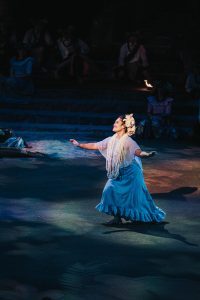
Mana’s Mother performs a beautiful hula for her son’s birthday
The mother’s hula is also an expression of love and hope for her child. It is quite common at a Hawaiian birthday lūʻau for family members to hula for the child being celebrated. In HĀ, the mother performs her hula to the beautiful song Kamanau’laokalani. The name of this song comes from Mana’s extended name in Hawaiian and it was composed by Cy Bridges specifically for the show. This and many other songs are available to enjoy on your favorite streaming apps.
HĀ the Breath of Life

Mana’s father gives his son a special gift and teaches him about his HĀ
It is also in this act that we see the true significance of the show’s name, HĀ: Breath of Life. Aloha, the common Hawaiian greeting, can be separated into the words Alo, meaning presence, and HĀ, meaning breath, making the true translation of this greeting the “presence of breath.” Breath in the Hawaiian culture is representative of life. This is why Hawaiians will tell you that Aloha is not just a word, it is a way of life. The Polynesian Cultural Center has made it their mission to share this philosophy with the world, which their motto reflects, “One ʻOhana (family), sharing Aloha“
During Mana’s birthday celebration he is given a special gift by his father, something that has been passed down through the generations of their family. This pendant was specifically designed for HĀ. It looks similar to the Maori koru design which represents life unfolding and a new beginning or rebirth. However, unlike the koru inspiration, the HĀ pendant, flares out at the end. This deviation is intended to give the impression that this pendant could be a representative of many cultures. This bone carving is used in the evening show as a visible representation of HĀ, the breath of life, that is passed through generations.
When Mana’s father passes on this pendant, that was a gift from his own father, he is reminding Mana that his father and his other ancestors will always be with him, in the breath that gives him life.
Aloha to all
The Polynesian Cultural Center is proud to present our guests with this beautifully symbolic representation of the wonders of the Hawaiian culture. Rich in tradition, and dedicated to living and sharing Aloha, Hawaiʻi is truly a paradise that blesses those who visit our shores. We hope you’ve enjoyed this overview of Act 2 of HĀ: Breath of Life.
Want to learn more about Hawaiʻi and the other cultures of Polynesia?
Read our deep dive into Act One to learn more about Tongan Culture.
Enjoy some of our most popular blogs based on Hawaiian culture, including recipes, history and travel.
A Lūʻau History: Keeping Tradition Alive in Hawaiʻi – polynesia.com | blog
Kalua Pig, Hawaiian Style in Your Own Kitchen – polynesia.com | blog
Three Hawaiian Legends Travelers May Want to Know – polynesia.com | blog
Review our extensive library of blogs covering various aspects of this and other Polynesian cultures at Cultures of Polynesia Archives – polynesia.com | blog
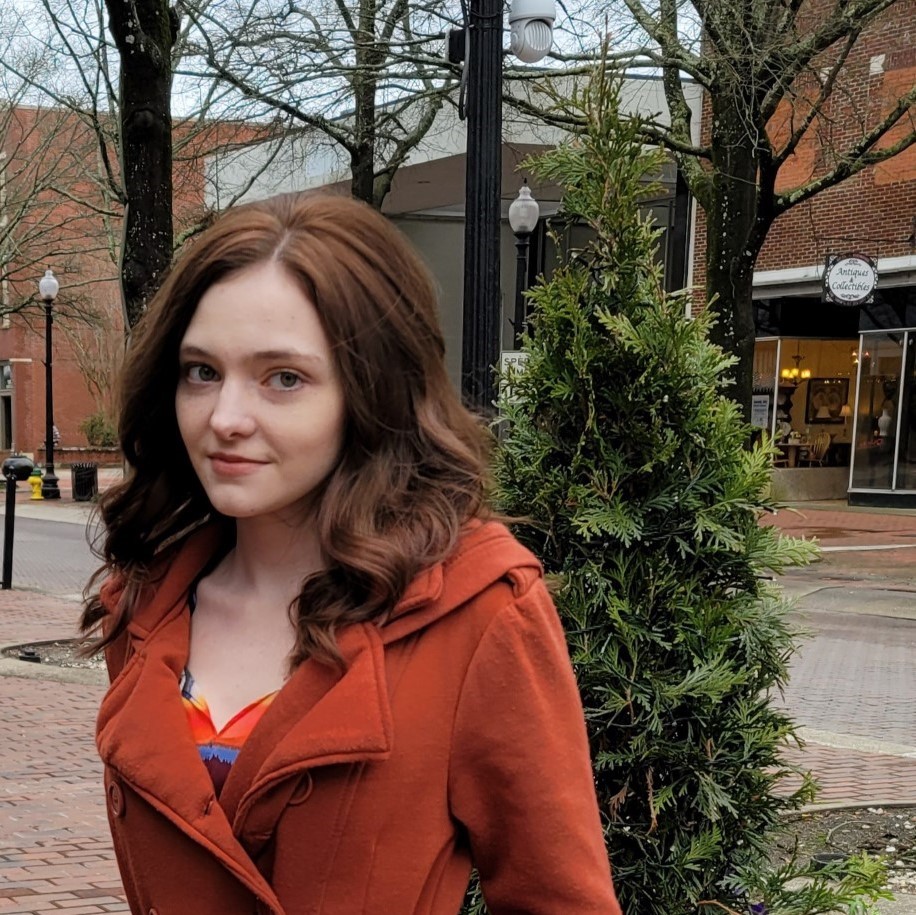
Bio of Harley M. Charlebois, Blogger for the Polynesian Cultural Center
If I’m not traveling, you’ll usually find me at my favorite tea shop with a pencil and pad, I’m old school like that. Otherwise, you’ll find me eating, shopping, or hanging with my kitten. I am always looking for new foods and experiences to share.

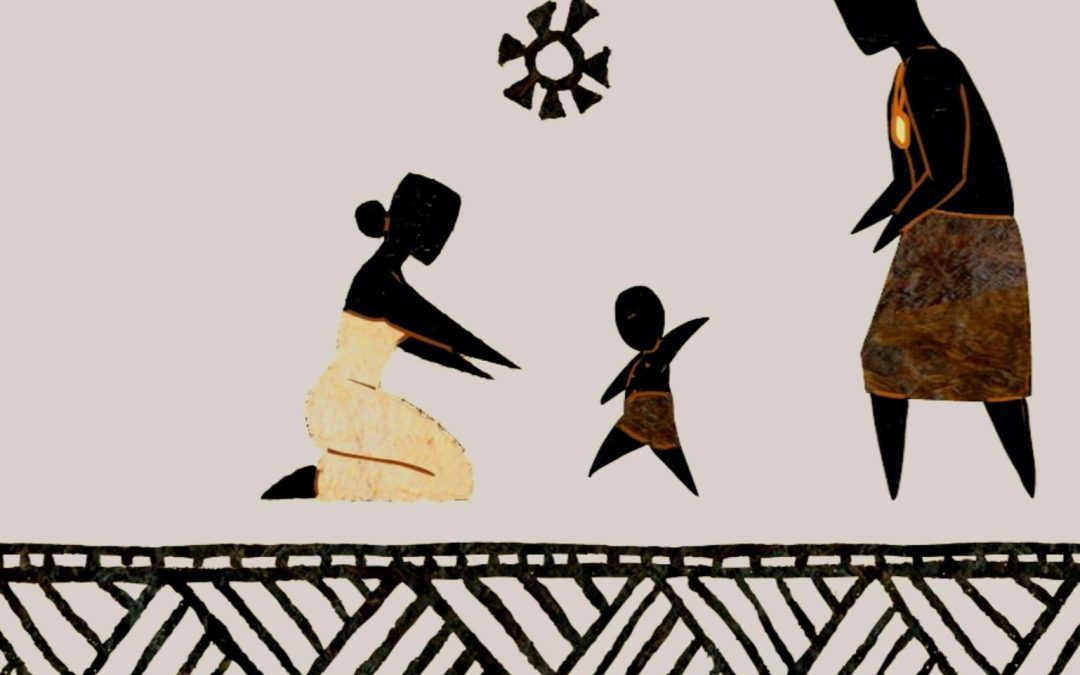
Recent Comments